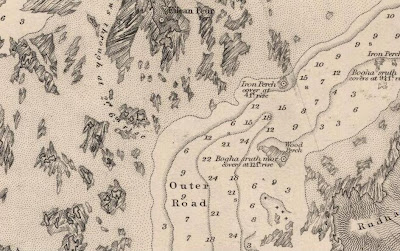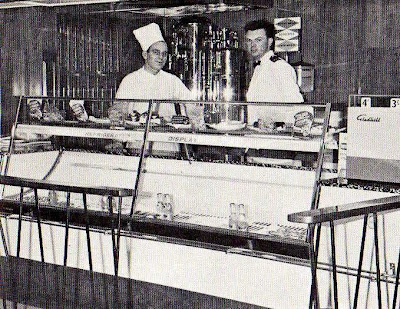It's the great gothic pile across the bay from Plockton in Wester Ross which featured prominently in "Hamish Macbeth". It was also the scene of the 2004 BBC docudrama "The Dobsons of Duncraig" featuring the extended Dobson family's attempts to transform the castle from dereliction into an upmarket guest house and falling out spectularly in the process.
It's not a castle at all, of course, but a Victorian mansion. It's said the ceilings are adorned with plaster mouldings of poppies and tacked on to its north end (though not visible in that picture) is an awful 1960s modernist institutional extension. This is why.
Duncraig Castle was built in 1866 for Sir Alexander Matheson. He was born in 1805 at nearby Attadale, the son of the tenant farmer there, but made an immense fortune as a partner in the Hong Kong firm of Jardine Matheson & Co. The eponymous co-founder, James Matheson, was Alexander's uncle. The core of JM&Co's business was importing opium into China in exchange for tea to be exported to Britain, hence the poppies on the ceilings at Duncraig: the firm's story was the inspiration for James Clavell's
Tai-Pan novels.
Alexander Matheson returned to Scotland, was knighted and bought Attadale before going on to amass a huge estate comprising almost the whole of the parish of Lochalsh (i.e. all the land bordered by Loch Carron down as far as Kyle on the north and west and Loch Alsh and Loch Long on the south east). With his other estate at Ardross Castle in Easter Ross, it made Matheson the biggest landowner in Ross-shire.
 |
| Note how some of the tower roofs have since been removed |
Duncraig is not Gothic either but what architects call Jacobean, in other words aping the style which followed Tudor when King James VI & I was on the throne of England (1603-25). It's characterised by clusters of tall narrow windows. The architect was Alexander Ross of Inverness who designed a number of Victorian mansion houses and shooting lodges in north west Scotland but also some more humble buildings including many parish schools in the 1870s.
Alexander Matheson was also a prime mover behind the construction of the railway from Inverness and Dingwall to Stromeferry in the 1870s. When the line was extended to Kyle of Lochalsh in 1897, it ran along the shore in front of Duncraig and a private railway station was built for the service of the house. This was common practice during the railway boom - it was sort of the Victorian equivalent of today's "community benefit" from building a wind farm except the benefit went to a local grandee (who in fairness had paid for a hefty chunk of the railway so the analogy is not exact.)
 |
| Duncraig Castle bottom right looking over Plockton to Applecross, the Crowlin Islands and Raasay - note the railway line along the shore in the left foreground |
In fact, Sir Alexander Matheson had died in 1886 so the benefit of the private station was for his son, Sir Kenneth. But as is often the case with
nouveaux riches, however, the money to maintain such a lavish country estate was not destined to pass down many generations and Kenneth Matheson sold Duncraig to Sir Daniel Hamilton in the 1920s (not sure of the exact date.) Hamilton also owned the neighbouring Balmacara Estate to the south of Duncraig - that had also belonged to the Mathesons but again I'm not sure if the two were bought together as all part of the same sale or not.
Daniel Hamilton had in common with Alexander Matheson that he had made money in a family business in the east, India this time. He bought a tract of land in a swamp called the Sunderbans in the Ganges Delta in Bengal, reclaimed it and did much to promote the interests of the local peasantry. He was a pioneer of what would now be called "micro-credit", was said to be close to Gandhi and is still remembered fondly in the Sunderbans. Back home in Scotland, he showed the same philanthropic spirit by bequeathing Balmacara Estate to the National Trust for Scotland and Duncraig Castle to Ross & Cromarty County Council for use as a domestic science college. Sir Daniel died in 1939 and these bequests were to take effect after the death of his wife, Lady Margaret. That happened in 1947 although during the war, Duncraig Castle was used as a naval hospital.
It was during its time as Duncraig Castle College, in 1969, that the hideous modernist extension was added to the north (left) end of the house. This is plainly obvious in the aerial photo above but fortunately it's largely masked by trees and not really obvious in the view from Plockton which is where most people see the Castle from.
Duncraig Castle College closed in 1989 but it took Highland Council 13 years to decide what to do with the building. Apart from accommodating the production team for "Hamish MacBeth" (1995-97 BBC series filmed on location around Plockton starring Robert Carlyle as a village policeman, in the same mould as "Monarch of the Glen"), it mostly lay empty and deteriorating rapidly: a house like Duncraig - any house - dies quickly if left empty in a damp climate like Wester Ross. In the 90s, I subscribed to the West Highland Free Press and recall endless stories about proposals for Duncraig being rented as a back-packers hostel being objected to vociferously by the residents of Plockton and coming to nothing.
 |
| The elevation to the sea is at the bottom as in the picture above and this plan doesn't include the 60s extension to the left |
Eventually, in 2002, the Council grasped the nettle and concluded it had no option but to sell the Castle. It was put on the market at offers over £350,000 and bought for £505,000 by Sam and Perlin Dobson, a couple from Nottinghamshire with experience in doing up and selling or renting houses. With plans to renovate it as an upmarket guest house-cum-wedding venue etc. (the Castle has a private chapel) Duncraig would be their biggest challenge. The Dobsons imported Sam's parents and several of his siblings and their families to join in the project - and a BBC film crew for good measure to catch them all falling out big style over the next two years and broadcast it to the nation in "The Dobsons of Duncraig". I didn't catch any of that series myself but you can read the unedifying details in this
New York Times article.
 |
| 60's extension cunningly hidden by the trees on the left |
All we need to know for present purposes is that once the dust had settled on the televised shenanigans of 2003-04 and the rest of the family had been evicted (literally, I gather), the Dobsons continued to run Duncraig Castle as a bed and breakfast for five years with some success. But they put it up for sale in early 2009 at offers over £750,000. I don't know how to link directly to a pdf but you can download the sale brochure from top people's estate agents Strutt & Parker via
this link (look for the "Download Duncraig" link near the top of that article).
It was bought by Suzanne Hazeldine who is continuing to run the Castle as a bed and breakfast. Duncraig gets pretty good write-ups on
Tripadvisor - you can see how people are just blown away by the location and views and the experience of staying in a "Scottish castle" although a regular theme of comments is having to try and ignore the decayed 60s extension as you sweep up the driveway (it's never been occupied again since the college closed in 1989 and the new owner now has plans to demolish it).
 |
| The view from Lady Matheson's Room |
Meanwhile, Highland Council used the proceeds of sale of the Castle as an endowment for the Duncraig Educational Trust Scheme which makes grants to young people from the Highlands pursuing further education - it seems a reasonable compromise considering the Council couldn't retain Sir Daniel Hamilton's bequest of the building itself.
To bring some other threads of the story up to date, Jardine Matheson & Co is still very much in business and still trading in tea, though not opium. Now known as just "Jardines", the company is still based in Hong Kong, privately owned and run by Scots, the direct descendants of founder William Jardine. Though not a household name itself, perhaps Jardines' best known subsidiary is the Mandarin Oriental luxury hotel chain.
The private railway station, with its miniature octagonal waiting room, remains open as Duncraig Station albeit just a request stop now. I can understand why they kept it open while the college was still going but you can't help thinking it must now be near the top of Network Rail's "to close" list - if I were a railway buff (which I'm not really enough of), I'd be making a point of getting on (or off, or both) at Duncraig soon before the opportunity is lost for ever.
Sir Alexander Matheson's uncle, James Matheson, the co-founder of Jardine Matheson & Co, also bought a Scottish estate, the whole island of Lewis. And he built in 1847 a castle of similar style and dimensions to Duncraig which also became a college. Happily, though, Lews Castle at Stornoway has managed to retain its further education function to the present as Lews Castle College, a campus of the University of the Highlands and Islands.
 |
| Lews Castle, Stornoway - Photo credit Steve |
As far as I know, however, there are no poppies moulded in the ceilings of Lews Castle as there are at Duncraig Castle.
And finally, I expect Sir Daniel Hamilton would have approved of the recent trend towards community ownership of Scottish country estates in the Highlands. Indeed, I wonder if he's not kicking himself in his grave that he didn't leave Balmacara-Duncraig to Plockton Community Trust (or some such) rather than the National Trust. I wonder who he left his estate in Bengal to?

























































